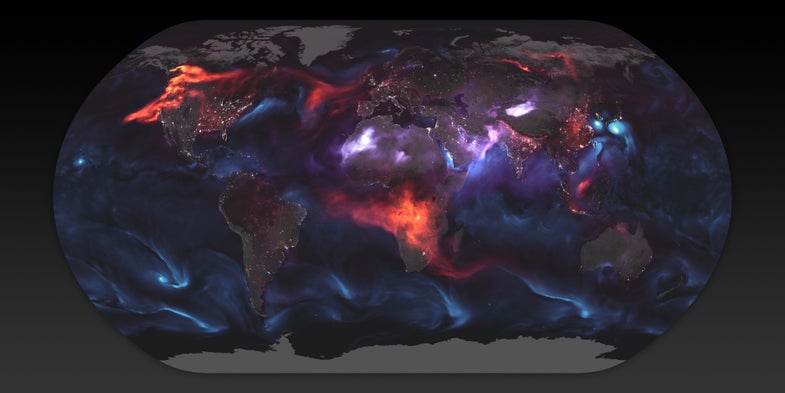This beautiful map of Earth’s atmosphere shows a world on fire
Salt, smoke, and dust.

Our atmosphere is dominated by gas, chock-full of nitrogen and oxygen, with trace amounts of other gases all swirling around our planet. But that’s not the only state of matter represented in the area between the ground and space. Liquid water makes a frequent appearance, and so do solid particles fine enough to hang suspended in the air.
These particles can come from many different sources, both natural and human-caused. And while they’re small enough to be invisible to us, they’re easily detected by instruments on NASA’s satellites and ground based equipment.
Above is a visualization created by NASA researchers of the particulates present in our atmosphere on a single day—August 23, 2018. They used a computer model that incorporates data from NASA instruments all over (and above) the world, adding in information on temperature, rainfall, and pressure to get an idea what kinds of particles are located around the globe, and where they lurk.
The bright blue dots indicate salt sprayed up into the atmosphere. To the left, in the middle of the Pacific, is Hurricane Lane—a storm that made a rare approach toward the Hawaiian islands. In Asia (to the right) you can see similar dots of salt sprayed into the air by cyclones Soulik and Cimaron.
The purple haze spreading across Western China, North Africa, and the Middle East is made up of dust particles, blown into the air off of deserts. Dust can have far reaching consequences, with particles from China’s Gobi desert providing nutrients to sequoias in California and Saharan dust fertilizing the Amazon.
Then there’s the red. On the image above, it represents black carbon, or small particles of material released by combustion—whether that’s from cropland in southern Africa, fuel to power cars, or wildfires eating through trees, grasses, and homes.
For comparison, check out this image (also compiled by NASA) of fires around the world, from data gathered on August 22, 2018.

In North America the fires are predominantly wildfires, while in Africa, farmers are typically burning fields deliberately in an effort to fertilize the ground and prepare for the next growing season. Brazil has a mix between purposeful blazes and wildfires.
Particles in the air can be a problem for human health in high concentrations, and while this map doesn’t explicitly focus on air pollution, polluted air is estimated to prematurely kill over 3 million people a year, affecting people’s brains, hearts, and lungs.